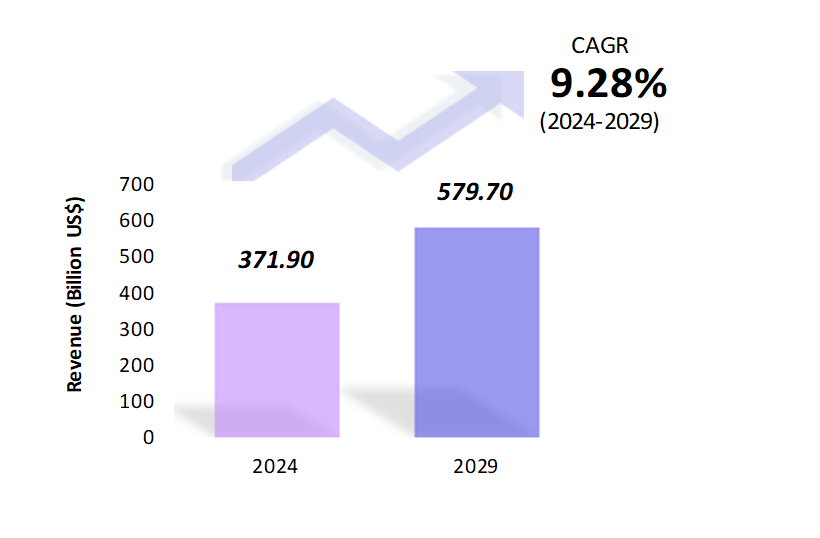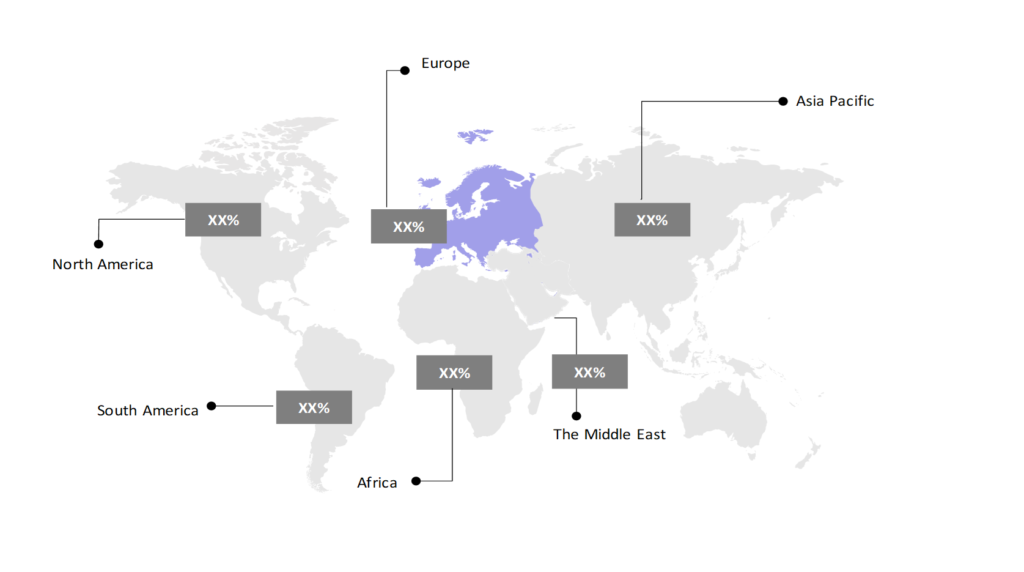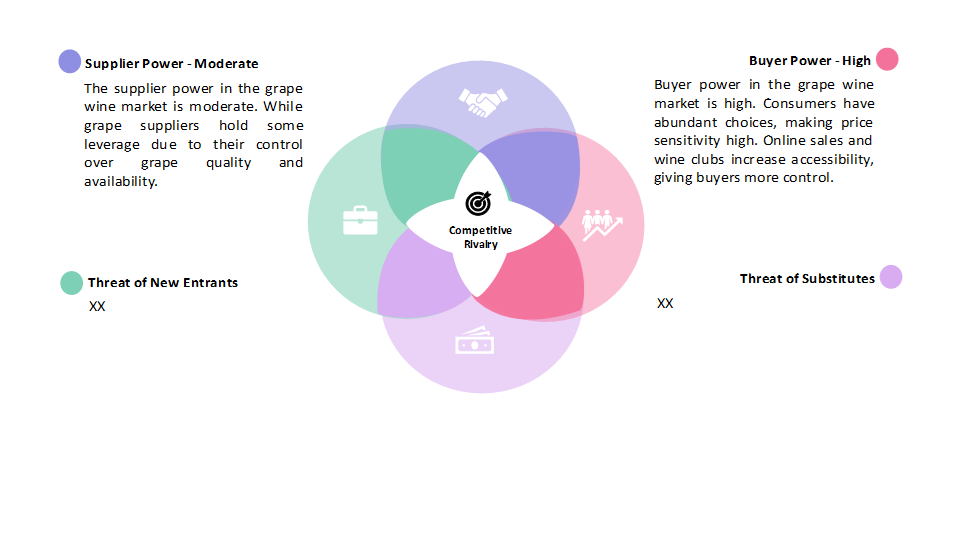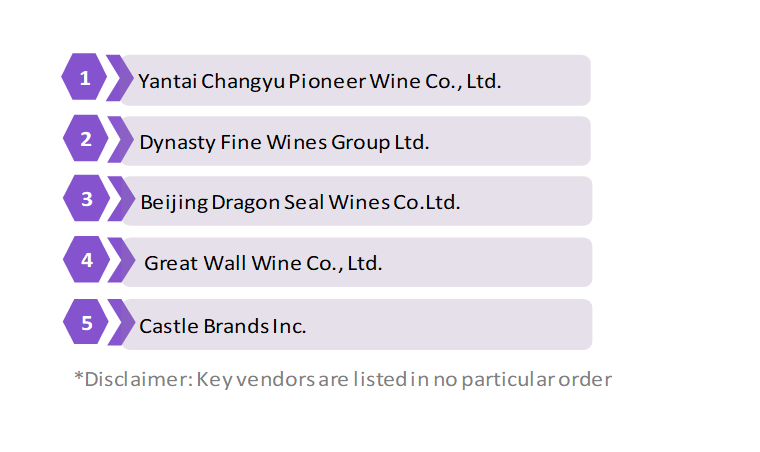Grape Wine Market: Size, Share, Trends & Forecast (2024-2029)
The report covers a comprehensive analysis segmented by Type (Red Wine, White Wine, Rose Wine, Others), By Application (Commercial Consumption, Household Consumption), and Geography (North America, South America, Asia Pacific, Europe, The Middle East, Africa).
Grape Wine Market Snapshot

Grape Wine Market Overview
The global grape wine market market is estimated to be at $371.90 Bn in 2024 and is anticipated to reach $579.7 Bn in 2029. The global grape wine market market is registering a CAGR of 9.28% during the forecast period 2024-2029
The grape wine market encompasses a vast and diverse landscape, characterized by a wide range of products catering to various consumer preferences and demographics. Globally, wine consumption has been on the rise, driven by factors such as changing lifestyles, increasing disposable incomes, and growing interest in wine culture. Europe, particularly countries like France, Italy, and Spain, has traditionally been a dominant force in the grape wine market, renowned for its centuries-old winemaking traditions and heritage. However, in recent years, new world wine-producing regions such as the US, Australia, Chile, and Argentina have gained prominence, offering innovative styles and flavors to meet evolving consumer demands.
In terms of distribution, the grape wine market has witnessed a significant shift towards online retail channels, driven by the convenience of e-commerce platforms and the increasing digitalization of shopping habits. However, traditional brick-and-mortar stores, specialty wine shops, and on-premises establishments such as restaurants and bars continue to play a crucial role in wine sales and consumption. Challenges facing the grape wine market include climate change-related disruptions in wine-growing regions, regulatory complexities, and changing consumer preferences. Additionally, competition from alternative beverages like craft beer and spirits poses a threat to market share. To navigate these challenges and capitalize on opportunities, wine producers must focus on product innovation, sustainability, branding, and digital marketing strategies to maintain a competitive edge in the dynamic grape wine market.
Grape Wine Market Coverage
| Historical & Forecast Period | 2018-2029 |
| Base Year | 2023 |
| Forecast Period | 2024-2029 |
| Units | Billion US$ |
| Segments | Type, Application |
| Geographies | North America, South America, Asia Pacific, Europe, the Middle East, Africa |
| Key Vendors |
Yantai Changyu Pioneer Wine Co., Ltd., Dynasty Fine Wines Group Ltd., Beijing Dragon Seal Wines Co. Ltd., Great Wall Wine Co., Ltd., Castle Brands Inc. |
Key Geographies of Grape Wine Market, 2023

Porter’s 5 Forces Analysis of Grape Wine Market

Grape Wine Market Trends
The grape wine market has seen a notable trend towards premiumization, driven by rising consumer demand for higher quality and more sophisticated wine options. This trend has led to an increase in the production and consumption of premium and ultra-premium grape wines, Furthermore, there has been a growing interest in organic and sustainably produced grape wines, reflecting consumers’ preferences for environmentally friendly products. This shift towards sustainability has prompted many wineries to adopt organic farming practices and eco-friendly production methods. Additionally, the grape wine market has witnessed significant innovation and experimentation, with winemakers exploring new grape varieties, blending techniques, and aging processes to cater to evolving consumer tastes. This has resulted in a diverse range of wine styles and flavor profiles, appealing to a broader audience of wine enthusiasts.
Moreover, the advent of e-commerce and online wine retailers has transformed the distribution landscape, making it easier for consumers to access a wide selection of grape wines from around the world. This has contributed to the globalization of the grape wine market, allowing consumers to explore and discover wines from different regions and producers with greater convenience. Overall, the grape wine market is characterized by a shift towards premiumization, sustainability, innovation, and globalization. These trends are expected to continue shaping the market in the near future, driving further growth and evolution in the industry.
Grape Wine Market Driving Factors
The driver analysis of the grape wine market reveals several key factors influencing its growth and trends. Changing consumer preferences towards healthier lifestyles have increased the demand for wine, particularly as it is perceived as a healthier alternative to other alcoholic beverages. Additionally, the growing popularity of wine as a social drink and its incorporation into culinary experiences have further boosted market demand. Moreover, the expansion of grape cultivation regions, facilitated by advancements in agricultural technology and favorable climatic conditions in certain regions, has contributed to increased grape wine production. This has led to a wider variety of wines being available on the market, catering to diverse consumer preferences.
Furthermore, globalization and international trade agreements have facilitated the easy movement of wine across borders, promoting market growth. The emergence of online retail platforms and e-commerce channels has also made it easier for consumers to access a wide range of grape wines from different regions and producers. Additionally, marketing and promotional efforts by wine producers, including branding, advertising, and educational campaigns, have raised awareness and interest in grape wines, further driving market growth. Furthermore, the increasing popularity of wine tourism, where consumers visit vineyards and participate in wine-tasting experiences, has not only contributed to direct sales but also enhanced brand loyalty and consumer engagement. Overall, the grape wine market is influenced by a combination of factors including changing consumer preferences, technological advancements, globalization, marketing strategies, and the rise of wine tourism, all of which contribute to its sustained growth and evolution.
Grape Wine Market Challenges
The grape wine market is a dynamic and multifaceted industry influenced by various factors such as consumer preferences, economic conditions, and global trends. Sustainable practices and organic certification are also gaining traction, reflecting consumer preferences for environmentally friendly and ethically produced wines. However, the grape wine market faces several challenges, including fluctuating grape prices, climate change-induced disruptions in wine-growing regions, and regulatory hurdles related to labeling, distribution, and taxation.
Additionally, competition from other alcoholic beverages like craft beer and spirits poses a threat to market share. To thrive in this competitive landscape, wine producers must adapt to changing consumer preferences, invest in innovation and sustainability, and leverage digital marketing and distribution channels to reach a broader audience. Collaborations and partnerships within the industry, along with strategic branding and market positioning, are also crucial for long-term success in the grape wine market. Moreover, shifting consumer preferences towards healthier and low-alcohol options challenge traditional wine consumption patterns. Economic uncertainties, like fluctuations in currency exchange rates and income levels, further contribute to market volatility. Changing demographics and cultural shifts impact wine consumption habits, requiring industry players to adapt their offerings to evolving consumer preferences. Overcoming these challenges demands a multifaceted approach, incorporating sustainability measures, regulatory advocacy, technological innovation, and consumer education efforts to ensure the long-term success of the grape wine market.
Grape Wine Market – Key Industry News
- In August 2023, The Fladgate Partnership announced that it has purchased the estates and brands of Ideal Drinks. The deal includes inventory, brands, wineries, and nearly 500 acres of vineyards outside the Douro.
- In July 2023, Torres China has decided to acquire Summergate through a partnership agreement that aims to drive the next stage of imported wine business in China.
- In September 2023, E. & J. Gallo’s Luxury Wine Group has acquired Napa Winery, Napa Valley’s only white wine producer’s Massican Wines.
Grape Wine Market Competitive Landscape
The participants in the global grape wine market industry are always developing their strategies to preserve a competitive advantage. Companies primarily use acquisitions, R&D, partnerships, and technological launches. Several important entities in the grape wine market include Yantai Changyu Pioneer Wine Co., Ltd., Dynasty Fine Wines Group Ltd., Beijing Dragon Seal Wines Co.Ltd., Great Wall Wine Co., Ltd. Castle Brands Inc. And others.
Smaller, more upscale wineries are gaining popularity because they provide unique flavors that some consumers find particularly appealing. Additionally, the internet has made it simpler for new businesses to begin selling wine online. So, to stand out, companies are trying new things like being eco-friendly, selling organic wine, and producing clever ways to advertise to attract meticulous customers.
Grape Wine Market Company Share Analysis, 2023(%)

Grape Wine Market – Key Companies

Reason to Buy from us

Table of Contents
| 1. Introduction |
|---|
| 1.1. Research Methodology |
| 1.2. Scope of the Study |
| 2. Market Overview / Executive Summary |
| 2.1. Global Grape Wine Market (2018 – 2022) |
| 2.2. Global Grape Wine Market (2023 – 2029) |
| 3. Market Segmentation |
| 3.1. Global Grape Wine Market by Type |
| 3.1.1. Red Wine |
| 3.1.2. White Wine |
| 3.1.3. Rose Wine |
| 3.1.4. Others |
| 3.2. Global Grape Wine Market by Application |
| 3.2.1. Commercial Consumption |
| 3.2.2. Household Consumption |
| 4. Regional Segmentation |
| 4.1. North America |
| 4.2. South America |
| 4.2.1. Brazil |
| 4.2.2. Argentina |
| 4.2.3. Colombia |
| 4.2.4. Chile |
| 4.2.5. Rest of South America |
| 4.3. Asia Pacific |
| 4.3.1. China |
| 4.3.2. India |
| 4.3.3. Japan |
| 4.3.4. South Korea |
| 4.3.5. Rest of Asia Pacific |
| 4.4. Europe |
| 4.4.1. UK |
| 4.4.2. Germany |
| 4.4.3. Italy |
| 4.4.4. France |
| 4.4.5. Spain |
| 4.4.6. Rest of Europe |
| 4.5. The Middle East |
| 4.5.1. Turkey |
| 4.5.2. UAE |
| 4.5.3. Saudi Arabia |
| 4.5.4. Rest of the Middle East |
| 4.6. Africa |
| 4.6.1. Egypt |
| 4.6.2. South Africa |
| 4.6.3. Rest of Africa |
| 5. Value Chain Analysis of the Global Grape Wine Market |
| 6. Porter Five Forces Analysis |
| 6.1. Threats of New Entrants |
| 6.2. Threats of Substitutes |
| 6.3. Bargaining Power of Buyers |
| 6.4. Bargaining Power of Suppliers |
| 6.5. Competition in the Industry |
| 7. Trends, Drivers and Challenges Analysis |
| 7.1. Market Trends |
| 7.1.1. Market Trend 1 |
| 7.1.2. Market Trend 2 |
| 7.1.3. Market Trend 3 |
| 7.1.4. Market Trend 4 |
| 7.1.5. Market Trend 5 |
| 7.2. Market Drivers |
| 7.2.1. Market Driver 1 |
| 7.2.2. Market Driver 2 |
| 7.2.3. Market Driver 3 |
| 7.2.4. Market Driver 4 |
| 7.2.5. Market Driver 5 |
| 7.3. Market Challenges |
| 7.3.1. Market Challenge 1 |
| 7.3.2. Market Challenge 2 |
| 7.3.3. Market Challenge 3 |
| 7.3.4. Market Challenge 4 |
| 7.3.5. Market Challenge 5 |
| 8. Regulatory Landscape |
| 9. Competitive Landscape |
| 9.1. Yantai Changyu Pioneer Wine Co., Ltd. |
| 9.2. Dynasty Fine Wines Group Ltd. |
| 9.3. Beijing Dragon Seal Wines Co. Ltd. |
| 9.4. Great Wall Wine Co., Ltd. |
| 9.5. Castle Brands Inc. |
| 9.6. Company 6 |
| 9.7. Company 7 |
| 9.8. Company 8 |
| 9.9. Company 9 |
| 9.10. Company 10 |
Grape Wine Market – Frequently Asked Questions (FAQs)
What is the current size of the global grape wine market?
The market size for the global grape wine market in 2024 is $371.90 Bn.
Who are the major vendors in the global grape wine market?
The major vendors in the global grape wine market are Yantai Changyu Pioneer Wine Co., Ltd., Dynasty Fine Wines Group Ltd., Beijing Dragon Seal Wines Co.Ltd., Great Wall Wine Co., Ltd., Castle Brands Inc.
Which segments are covered under the global grape wine market segments analysis?
This report offers in-depth insights into each type and application.
